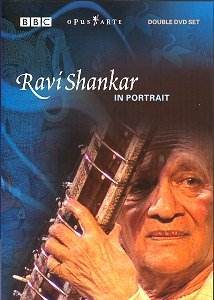This is a superb production, and should be in the
collections of anyone in the least bit interested in Indian classical
music. The BBC has given us a pair of discs, the first being a documentary
of Shankar’s life and performing history and the second gives us a live
recital in a very appropriate setting. Although the recital was given
in a church, backdrops have been created to give a somewhat exotic set
which is enhanced greatly by careful shooting and direction by the unnamed
Director.
Shankar’s performing life is fairly well known, with
his interest in working with such musicians as Yehudi Menuhin, George
Harrison, John Coltrane and others. The documentary is well prepared
and structured and gives a fairly rounded pictures of his life as a
teacher of the instrument and itinerant teacher. It also covers Ravi
Shankar’s withdrawal from the world of rock music and his more recent
concentration on teaching of his instrument and his core repertoire.
The latter activities have more recently concentrating
on his daughter Anoushka, who through his guidance is developing into
a very competent artist in her own right. She has not yet got the experience
which her father has, but this is growing and I have no doubt that she
will flower in the next 10 –15 year, by which time she will probable
have amassed the requisite experience to carry on her father’s work.
The first disc ends with Ravi Shankar teaching a new
work to a group of his students. This will give any interested watcher
a superb insight not only on how to get the most out of the instrument,
but also some of the philosophy behind the art of Indian Classical Music.
I found this first disc most instructive and above all entertaining
with superb views of various parts of India including religious festivals
on the Ganges and the Taj Mahal.
We then come to the second disc which consists of two
ragas, played in London in 2002. Ravi Shankar is joined by his daughter,
Anoushka, plus two tabla players of international reputation. In addition
to these players, there is another player who comes into view only sporadically
no doubt contributing to the proceedings, but only seen once or twice
through the recital and not credited anywhere.
These players are obviously completely immersed in
the proceedings and they carry the very quiet but appreciative audience
with them. The only thing which I found slightly off-putting was Anoushka’s
habit of winking at her father throughout the proceedings. I am not
sure what these represented, but the proceedings certainly are not compromised
by the strange habit.
The first raga is in two parts with a pause between
them – the first part being for sitar(s) alone with no contribution
from the tabla. Once the short pause is over, the second part of the
raga gets underway with a significant contribution from the expertly
played percussion instrument. The second raga does not have such a gap,
but is far more rhythmical and moves to a very exciting conclusion.
Both audio and video quality are superb, and the BBC
should be congratulated for this release.
John Phillips

